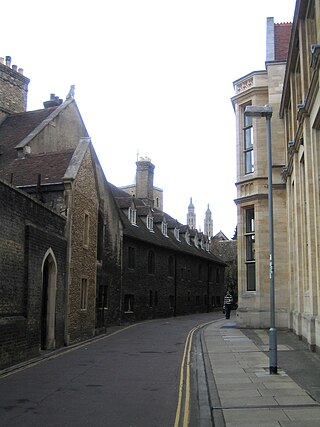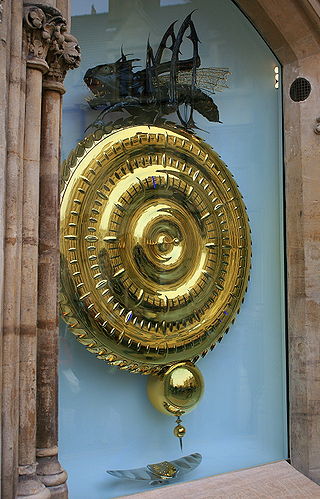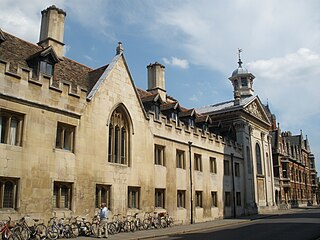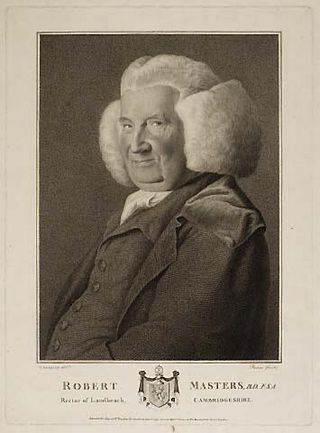
Corpus Christi College is a constituent college of the University of Cambridge. From the late 14th century to the early 19th century it was also commonly known as St Benet's College.

Thomas Hobson was an English carrier, best known as the origin of the expression Hobson's choice.
St Benet or St Benet's may refer to:

Since 1961 Leckhampton has been the residential site for postgraduate students of Corpus Christi College of the University of Cambridge, England. It consists of the late-19th-century Leckhampton House, the George Thomson Building, dating from 1964, and several other nearby houses. In 2012, a new, purpose-built accommodation building was built to house additional students. The new building was opened on 14 September 2012 by the College Visitor and Chancellor of the University, David Sainsbury.

Free School Lane is a historic street in central Cambridge, England which includes important buildings of University of Cambridge. It is the location of the Whipple Museum of the History of Science, the Department of History and Philosophy of Science (HPS,) the University's faculty of Social and Political Sciences, and is the original site of the Engineering Department, and the Physics Department's Cavendish Laboratory. At the northern end is Bene't Street and at the southern end is Pembroke Street. To the east is the New Museums Site of the University. To the west is Corpus Christi College.

The Eagle is a Grade II listed public house in Cambridge, England which opened in 1667 as a coaching inn. It is the second oldest pub in Cambridge, after the Pickerell Inn. The street frontage, located on the north side of Bene't Street in the centre of the city, is of circa 1600, with a galleried 19th-century wing behind, facing the courtyard. The site is owned by Corpus Christi College and is managed by Greene King brewery.

The Corpus Clock, also known as the Grasshopper clock, is a large sculptural clock at street level on the outside of the Taylor Library at Corpus Christi College, University of Cambridge, in the United Kingdom, at the junction of Bene't Street and Trumpington Street, looking out over King's Parade. It was conceived and funded by John C. Taylor, an old member of the college.

King's Parade is a street in central Cambridge, England. The street continues north as Trinity Street and then St John's Street, and south as Trumpington Street. It is a major tourist area in Cambridge, commanding a central position in the University of Cambridge area of the city. It is also a place frequented by many cyclists and by students travelling between lectures during term-time.

Trumpington Street is a major historic street in central Cambridge, England. At the north end it continues as King's Parade where King's College is located. To the south it continues as Trumpington Road, an arterial route out of Cambridge, at the junction with Lensfield Road.

Pembroke Street is a street in central Cambridge, England. It runs between Downing Street and Tennis Court Road at the eastern end and a junction with Trumpington Street at the western end. It continues west on the other side of Trumpington Street as Mill Lane.

Silver Street is located in the southwest of central Cambridge, England. It links Queen's Road to the west with Trumpington Street to the east. The road continues west out of central Cambridge as Sidgwick Avenue.

Market Hill is the location of the marketplace in central Cambridge, England. Operating as a marketplace since Saxon times, a daily outdoor market with stalls continues to run there.

St Bene't's Church is a Church of England parish church in central Cambridge, England. Parts of the church, most notably the tower, are Anglo-Saxon, and it is the oldest church in Cambridgeshire as well as the oldest building in Cambridge.
Michael Tyson was an English Anglican priest, academic, antiquary, and artist.

Robert Masters (1713–1798) was an English clergyman and academic, known as the historian of Corpus Christi College, Cambridge.

St Edward's Passage, known in the 18th century as Chain Lane, is a Y-shaped alleyway in Cambridge, England, between King's Parade—opposite the main gate of King's College—and Peas Hill. It houses the entrance and churchyard of the Church of St Edward King and Martyr; the Cambridge Arts Theatre; several cottages; G. David, an independent bookshop run from the same building since 1896; a few businesses; and student accommodation. It is a narrow, dark lane, with riven-stone paving, which opens out onto the much wider and sunnier King's Parade.

The following is a timeline of the history of the city of Cambridge, England.

John Barnardiston was an English clergyman and librarian. Born in London c. 1719, he was the son of George Barnardiston, a lawyer who was a member of the Middle Temple. Growing up, Barnardiston studied at Tonbridge School, which awarded him an exhibition to study at Corpus Christi College, Cambridge as a sizar in 1737. He studied at the University of Cambridge for seven years, being awarded a Bachelor of Arts in 1741 and a Master of Arts in 1744. In the next year, Barnardiston became a fellow of Corpus Christi College and continued to hold that position until 1759.
Richard de Billingford was Chancellor of the University of Cambridge, holding the position three times, from 1400–1402, 1406-1413 and in 1432.




















